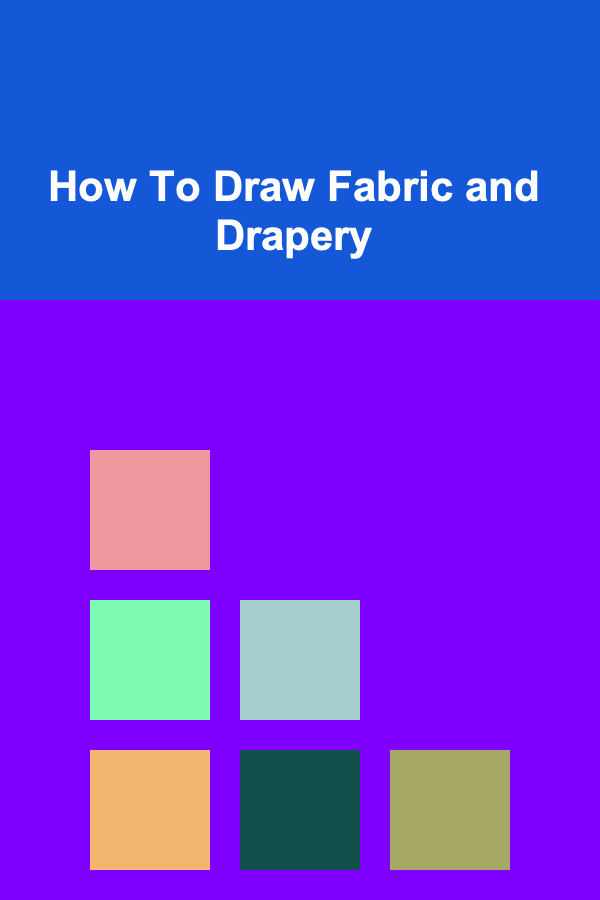
How To Draw Fabric and Drapery
ebook include PDF & Audio bundle (Micro Guide)
$12.99$9.99
Limited Time Offer! Order within the next:

Drawing fabric and drapery is one of the most challenging yet rewarding artistic skills to master. The way fabric folds and flows, how light interacts with its texture, and the deep folds of drapery can add immense realism and emotion to any artwork. Whether you're sketching a still life, designing a character, or creating a dramatic scene, the ability to render fabric convincingly will elevate your work significantly.
In this guide, we will delve into the nuances of drawing fabric and drapery, exploring techniques, tips, and best practices to help you accurately depict the flow, texture, and lighting of cloth.
Understanding Fabric and Drapery
Before picking up your pencil or brush, it's essential to understand what you're trying to depict. Fabric and drapery are dynamic and reactive to the forces around them, such as gravity, tension, and movement. Each type of fabric behaves differently, and understanding these subtleties is key to capturing them in your artwork.
Types of Fabric
- Soft Fabrics: These fabrics, such as cotton, silk, and velvet, tend to flow easily, creating smooth, rounded folds. They often reflect light in soft gradients.
- Stiff Fabrics: Fabrics like linen, canvas, and denim are more rigid, creating sharp, angular folds. These types of fabrics maintain a structure even in a relaxed state.
- Stretch Fabrics: Spandex or jersey fabrics stretch and pull across surfaces, leading to tight, elongated folds. They often create a more smooth surface and exhibit reflective qualities.
Understanding the behavior of these fabrics will help you create more convincing drawings by predicting how they fold, reflect light, and interact with the body or environment.
Basic Principles of Drapery
Drapery typically refers to larger pieces of fabric that hang loosely and can be folded in intricate ways. The way drapery folds is dictated by factors like gravity, the weight of the fabric, and its tension.
Key types of folds include:
- Zigzag Folds: These are commonly found in soft fabrics and create a wave-like effect. They are typically seen in relaxed fabric lying in piles or hanging loosely.
- Pipe Folds: These are parallel and evenly spaced, typically formed in stiffer fabrics. They create a vertical flow and are often seen in more structured garments or curtains.
- Spiral Folds: These folds wrap around themselves, commonly found in heavier fabrics like velvet or drapery that is pulled into a spiral shape.
- Catenary Folds: These folds appear in relaxed, hanging fabric, where the fabric hangs in a symmetrical curve due to gravity.
Drawing Techniques for Fabric and Drapery
To successfully render fabric and drapery, you need to learn to break down the complex forms into manageable parts. The process can be broken into a few key steps: observation, sketching basic shapes, adding folds and texture, and rendering light and shadow.
1. Observing Fabric in Real Life
Before you begin drawing, observe the fabric closely. Pay attention to how the fabric moves, how it folds, and how light interacts with it. Place different types of fabric in front of you and note the differences.
Ask yourself questions like:
- Does the fabric hang loosely or is it stretched taut?
- What is the texture of the fabric, and how does it catch light?
- How do folds gather, and where are the creases sharp or soft?
When observing drapery, look at how it hangs and reacts to the forces around it. A window curtain, for instance, might form long, graceful folds while a bedspread might create a more compact, angular series of folds.
2. Blocking in Basic Shapes
Start by breaking the fabric down into simple shapes. Sketch the general outline of the fabric's flow before diving into the folds. Draw the outer contours of the drapery first, and make sure the fabric appears to have volume and movement. Often, starting with large, sweeping lines will help you establish the overall feel and direction of the folds.
Use light, sweeping lines to map out how the fabric will behave. For example:
- For a hanging curtain: Start by outlining the upper edge, which is typically held up, and sketch how the fabric falls down in large, smooth curves.
- For a tablecloth: Outline the edges of the fabric on the table and sketch the areas where the fabric folds over itself, such as at the corners.
- For a figure in clothing: Focus on outlining the contours of the garment first before adding specific folds and creases.
The goal is to get the overall shape of the fabric in place before adding complexity.
3. Adding Folds and Creases
Once you've outlined the general shape of the fabric, it's time to add folds. The folds should follow the natural direction and flow of the fabric. As you sketch the folds, remember that fabric behaves in a way that feels organic. Folds form in areas where there is tension or gravity acting on the fabric, and they often overlap in layers.
- Curved folds: These are common in fabrics that are draped loosely, such as a curtain or a piece of cloth cascading down. These folds should follow a curved shape, and you should work to keep the smoothness of the fabric in mind.
- Sharp folds: Found in stiffer fabrics, these folds can form sharp, straight lines. In such cases, the fabric creates more angular and defined folds.
- Inverted folds: These folds appear when the fabric is pulled tightly, creating creases in the opposite direction. This is common in clothing that fits snugly to the body or fabric that is tightly gathered.
When drawing the folds, pay attention to the spacing and density of the folds. In soft fabrics, folds may be closely packed together, whereas in stiffer fabrics, there may be more separation.
4. Detailing the Texture
Texture is key in making your fabric look realistic. Each fabric type has its unique texture that reacts to light and shadow differently. The texture can be represented in your drawing by using different shading techniques.
- Smooth Fabrics: For soft fabrics like silk or satin, use smooth, even shading to capture the subtle light reflections and smooth surface of the material.
- Textured Fabrics: For rougher textures like linen or burlap, add small marks or patterns that reflect the weave of the fabric. Use hatching or cross-hatching techniques to create the appearance of woven material.
- Shiny Fabrics: Fabrics like velvet or satin reflect light in a distinctive way. Use soft gradients to show how the light transitions over the surface of the fabric, and be mindful of where the highlights and shadows fall.
Be deliberate with how you depict the texture, and consider using varied shading techniques to capture the fabric's unique qualities. Adding small details like light reflections or the weaving pattern of the fabric can give it a more lifelike quality.
5. Rendering Light and Shadow
Light and shadow are critical in making fabric appear three-dimensional. Understanding how fabric reflects light and where shadows naturally fall will add depth and realism to your drawing.
- Soft Light: Soft fabrics like silk or cotton often create smooth, gentle gradients of light and shadow. Use light, gradual shading to suggest this softness.
- Hard Shadows: Fabrics with sharp folds or stiffer textures often cast harder, more defined shadows. Focus on creating sharp contrasts between light and dark areas.
- Highlighting: On shiny fabrics, such as satin, focus on creating bright highlights where light directly hits the fabric. The rest of the fabric will typically be darker, with subtle gradation to show the texture and flow.
In general, consider how the light source affects the fabric. The folds will create areas of both highlight and shadow, and these contrasts will help to define the form of the fabric. Use softer strokes for light areas and more pressure for shadows, paying attention to the fabric's thickness and the way light behaves on its surface.
6. Adding Realism with Details
After the basic folds, textures, and lighting are in place, consider adding additional details to elevate your drawing. These details might include:
- Small wrinkles: Especially in clothing or tightly-draped fabric, small wrinkles will appear where the fabric is compressed.
- Seams: For more structured fabrics like clothing, add stitching lines along seams and hems to give the fabric structure.
- Fabric Manipulation: Consider showing the way fabric interacts with the body or an object. For instance, if a person is sitting in a chair, you might show how the fabric gathers at the knees or creases where it's pulled.
These small, thoughtful additions help make the fabric feel more grounded and real in your artwork.
Practice and Observation
Drawing fabric and drapery is not something that can be perfected overnight. It requires observation, practice, and an understanding of how fabric behaves in various scenarios. The more you practice, the more intuitive the process will become.
Try drawing different fabrics in various settings---such as clothing on a figure, curtains hanging from a window, or a towel thrown across a chair. Each will offer different challenges, helping you refine your technique.
Conclusion
Drawing fabric and drapery is an art in itself, one that combines observation, technical skill, and an understanding of light and shadow. By carefully studying the fabric's behavior, practicing your drawing techniques, and paying attention to detail, you can create lifelike and dynamic representations of drapery and textiles in your artwork.
Whether you're a beginner or an experienced artist, mastering the art of drawing fabric will elevate the quality and realism of your drawings, making your art more expressive and compelling. Keep practicing, keep observing, and over time, your ability to draw fabric and drapery will become second nature.

10 Tips for Saving Money on Meal Delivery Services Without Sacrificing Quality
Read More
How to Bring the Outdoors Inside with Holiday Decorations
Read More
How to Use Transparent Storage Bins for Maximized Space Efficiency
Read More
The Public Affairs Manager's Toolkit: Proven Methods for Managing Public Relations and Policy Initiatives
Read More
How to Navigate Treacherous Terrain
Read More
10 Tips for Perfect Cables in Your Knitting Projects
Read MoreOther Products

10 Tips for Saving Money on Meal Delivery Services Without Sacrificing Quality
Read More
How to Bring the Outdoors Inside with Holiday Decorations
Read More
How to Use Transparent Storage Bins for Maximized Space Efficiency
Read More
The Public Affairs Manager's Toolkit: Proven Methods for Managing Public Relations and Policy Initiatives
Read More
How to Navigate Treacherous Terrain
Read More